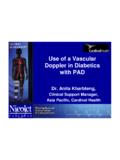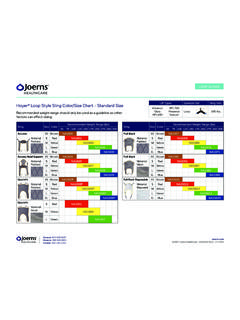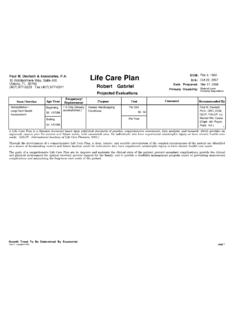Transcription of Physiotherapy Following Lower Limb Amputation
1 Physiotherapy Following Lower limb Amputation Protocols and Reference Material 2006 Prepared by the Physiotherapy Departments in SWAHS Western Cluster (Nepean Hospital, Blue Mountains Hospital, Springwood Hospital). 2006 Rehabilitation Quality Project Tony Fitzsimons, Andrew Clark, Alicia Symonds, MyKim Navarrete, Natalie Saad Penny Lees, Derek Lee, Katrina Shatford, Maggie Forde Physiotherapy Depts, SWAHS (Western Cluster) Fitzsmions, Clark, Symonds, Navarrete, Lees, Saad, Shatford, Forde, & Lee.
2 2 Table of Contents PRE-OPERATIVE ASSESSMENT CHECKLIST .. 4 SUBJECTIVE 4 OBJECTIVE 5 INSTRUCTIONS ON POST-OPERATIVE EXERCISES AND 5 POST-OPERATIVE ASSESSMENT 6 ACUTE MANAGEMENT OF 8 OEDEMA MANAGEMENT .. 10 RIGID DRESSINGS / REMOVABLE RIGID 11 Application of Rigid Dressing for Below Knee Amputees .. 13 Protocol for Removal of Rigid 14 Procedure for Removal of Rigid 14 Indications for Removal of Rigid Dressing Outside Set Periods .. 15 Application of Removable Rigid Dressing for Below Knee Amputees.
3 17 Notifying Physiotherapists of an Amputation Requiring a Rigid Dressing .. 18 ProTECtor System .. 19 20 Bandaging for Below Knee Amputation .. 22 Bandaging for Above Knee Amputation .. 23 Measuring Stump Size for 24 25 REFERENCES FOR STUMP 27 ADVICE FOR AMPUTEES: CARE OF THE STUMP AND 29 CARE OF THE 29 CARE OF THE 30 BEGINNING PROSTHETIC 31 Is the patient ready to begin prosthetic training: .. 31 When can the client take their temporary prosthesis home? .. 33 When is the patient ready for their definitive prosthesis?
4 33 REFERENCES:.. 34 COMPONENTS FOR DEFINITIVE 35 Feet ..35 Shanks .. 38 Knee 39 44 Suspension Systems for AKA Prostheses .. 46 Osseointegration .. 47 REFERENCES FOR PROSTHETIC 47 PROTOCOL FOR MAKING A BELOW KNEE TEMPORARY PROSTHESIS .. 49 PROTOCOL FOR MAKING AN ABOVE KNEE TEMPORARY PROSTHESIS 59 Physiotherapy Depts, SWAHS (Western Cluster) Fitzsmions, Clark, Symonds, Navarrete, Lees, Saad, Shatford, Forde, & Lee. 3 GAIT ANALYSIS AND TRAINING .. 66 BELOW KNEE AMPUTEE GAIT 66 ABOVE KNEE AMPUTEE GAIT 70 BELOW KNEE AMPUTEE GAIT ON 74 GAIT TRAINING 78 REFERENCES FOR 80 PAIN 82 FURTHER INFORMATION / 83 The information & protocols described in this manual are used at Nepean Hospital for amputee rehabilitation.
5 Often there are differences in protocols for reasons such as surgeons orders, materials or components used, or personal preferences in manufacturing techniques. It should be noted that there is some flexibility in how certain protocols are followed as long as the basic principles are adhered to. Physiotherapy Depts, SWAHS (Western Cluster) Fitzsmions, Clark, Symonds, Navarrete, Lees, Saad, Shatford, Forde, & Lee. 4 Pre-Operative Assessment Checklist Note that a generic Physiotherapy Amputee Assessment form has been developed by the NSW Physiotherapists in Amputee Rehabilitation special interest group, & is available on their website Subjective Examination Current History o Date, level & side of Amputation to be performed.
6 O Reason for the Amputation . Past Medical History o Co-morbidities which may impact on prosthetic use or rehabilitation, such as cardiorespiratory illness, diabetes, stroke or neurological illness, musculoskeletal illness such as OA or joint replacements. o Smoking history. o Medications. o Has there been a podiatry review for the other limb ? Social History o Where the client will likely return to after discharge, eg home, hostel, nursing home. o Who is at home to assist in ADL s, or could participate / supervise in their rehabilitation.
7 O Community supports. o Home environment o Are there stairs, & with or without rails. o Other modifications or equipment, eg rails in shower or toilet. Vocational activities o Work or recreational pursuits. o Driving, and type of vehicle, including automatic or manual. Premorbid Mobility Levels o Ability to manage bed mobility, transfers or standing up. o Is an aid or assistance required? o What terrains can be negotiated household, community, grass, stairs, crossing road, shopping, etc. o Endurance levels: is the client usually a household ambulator, outdoors, or community ambulatory, and what are the limiting factors?
8 O Is there a history of falls, and contributing factors. Pain o Pain in affected leg / unaffected leg. o Any other areas of pain o Consider patterns of pain and possible effects on the rehabilitation process. o May need to take a VAS scale. Physiotherapy Depts, SWAHS (Western Cluster) Fitzsmions, Clark, Symonds, Navarrete, Lees, Saad, Shatford, Forde, & Lee. 5 Goals o May or may not include prosthetic gait. Other goals can be wheelchair independence, transfer independence, improving bed mobility, etc.
9 Objective Examination Joint Range of motion o Lower and upper limbs. o Active o Passive Muscle Lengths o Main muscles at risk of shortening include hamstrings, hip flexors, intact limb plantarflexors. o Also consider risk to hip abductors / external rotators in above-knee Amputation . Muscle Strength o Assess by manual muscle test or functional testing. Condition of intact limb o Strength & range of motion o Presence of vascular disease ulcers, claudication. Arm Function o Strength & range of motion.
10 O Ability to use arms during transfers and with walking aids. Functional Assessments o Bed mobility o Sit to stand and transfers. o Gait, including ability to hop. Chest assessment. Instructions on Post-Operative Exercises and Positioning Short term goals include: o Maintenance of respiratory function o Maintenance of strength o Maintenance of range of motion & muscle lengths o Maintenance of cardiovascular fitness. See section: Acute Management of Amputees The client will likely also want information on the rehabilitation process and prosthetic limbs.







